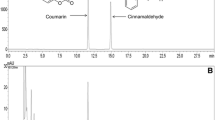Abstract
The toxicity of ethoxyquin (EQ) to rat kidney was examined in males which were either weanling or adult at the beginning of the experiment, and also in adult females. Female rats were much less susceptible to the toxic effects of EQ than males of the same age. In males damage to the cortex, mainly as an acceleration of the normal ageing process, was similar in both age groups, but rats exposed to EQ as weanlings also suffered from extensive papillary necrosis. Male rats were more prone than females to proteinuria, which was greatly exacerbated by EQ in both age groups. Thus there is very little evidence of nephrotoxicity in adult female rats on exposure to EQ at 0.5% in the diet for 26 weeks. In males, the initial age of the animal, as well as the length of treatment, influences the extent of damage.
Similar content being viewed by others
References
Cabral JRP, Neal GE (1987) Modification of aflatoxin B1 carcinogenesis by the antioxidant ethoxyquin. Am Assoc Cancer Res Proc Abstract No. 535, 135
Chung, FL, Wang M, Carmella SG, Hecht SS (1986) Effects of butylated hydroxyanisole on the tumorigenicity and metabolism of N-nitro-sodimethylamine and N-nitrosopyrrolidine in A/J mice. Cancer Res 46: 165–168
Green JA, Carthew P, Heuillet E, Simpson JL, Manson MM (1990) Cytokeratin expression during AFB1-induced carcinogenesis. Carcinogenesis 11: 1175–1182
Green JA, Edwards RE, Manson MM (1992) Immunohistochemical detection of bromodeoxyuridine labelled nuclei for in vivo cell kinetic studies. In: Manson MM (ed) Methods in molecular biology-immunochemical protocols, Vol. 10. Humana Press, New Jersey (in press)
Hagiwara A, Diwan BA, Ward JM (1986) Modifying effects of butylated hydroxyanisole, di(2-ethylhexyl)phthalate or indomethacin on mouse hepatocarcinogenesis initiated by N-nitrosodiethylamine. Jpn J Cancer Res 77: 1215–1221
Hard GC, Neal GE (1990) Induction of renal papillary necrosis in the rat by ethoxyquin. Toxicologist 10: 182
Hirose M, Masuda A, Hasegawa R, Wada S, Ito N (1990) Regression of butylated hydroxyanisole (BHA)-induced hyperplasia but not dysplasia in the forestomach of hamsters. Carcinogenesis 11: 239–244
Imaida K, Fukushima S, Inoue K, Masui T, Hirose M, Ito N (1988) Modifying effects of concomitant treatment with butylated hydroxyanisole or butylated hydroxytoluene on N,N-dibutyl nitrosamine-induced liver, forestomach and urinary bladder carcinogenesis in F344 male rats. Cancer Lett 43: 167–172
Inai K, Kobuke T, Nambu S, Takemoto T, Kuo E, Nishina H, Fujihara M, Yonehara S, Suehiro S, Tsuya T, Horiuchi K, Tokuoka S (1988) Hepatocellular tumorigenicity of butylated hydroxytoluene administered orally to B6C3F1 mice. Jpn J Cancer Res 79: 49–58
Ito N, Hirose M (1987) The role of antioxidants in chemical carcinogenesis. Jpn J Cancer Res 78: 1011–1026
Ito N, Fukushima S, Tsuda H (1985) Carcinogenicity and modification of the carcinogenic response by BHA, BHT and other antioxidants. CRC Crit Rev Toxicol 15: 109–150
Ito N, Hirose S, Fukushima H, Tsuda T, Shirai T, Tatematsu M (1986) Studies on antioxidants: their carcinogenic and modifying effects on chemical carcinogenesis. Food Chem Toxicol 24: 1071–1082
Kahl R (1986) The dual role of antioxidants in the modification of chemical carcinogenesis. J Environ Sci Health C4 [1]: 47–92
Kensler TW, Egner PA, Davidson NE, Roebuck BD, Pikul A, Groopman JD (1986) Modulation of aflatoxin metabolism, aflatoxin-N7-guanine formation and hepatic tumorigenesis in rats fed ethoxyquin: role of induction of glutathione-S-transferases. Cancer Res 46: 3924–3931
Mandel HG, Manson MM, Judah DJ, Simpson JL, Green JA, Forrester LM, Wolf CR, Neal GE (1987) Metabolic basis for the protective effect of the antioxidant ethoxyquin on aflatoxin B1 hepatocarcinogenesis in the rat. Cancer Res 47: 5218–5223
Manson MM, Legg RF, Watson JV, Green JA, Neal GE (1981) An examination of the relative resistances to aflatoxin B1 and susceptibilities to γ-glutamyl-p-phenylene diamine mustard of γ-glutamyl transferase negative and positive cell lines. Carcinogenesis 2: 661–670
Manson MM, Green JA, Driver HE (1987) Ethoxyquin alone induces preneoplastic changes in rat kidney whilst preventing induction of such lesions in the liver by aflatoxin B1. Carcinogenesis 8: 723–728
Mizumoto K, Ito S, Kitazawa S, Tsutsumi M, Denda A, Konishi Y (1989) Inhibitory effect of butylated hydroxyanisole administration on pancreatic carcinogenesis in Syrian hamsters initiated with N-nitrosobis(2-oxopropyl)amine. Carcinogenesis 10: 1491–1494
Nakagawa Y, Tayama K (1988) Nephrotoxicity of butylated hydroxytoluene in phenobarbital-pretreated male rats. Arch Toxicol 61: 359–365
Preat V, de Gerlache J, Lans M, Taper H, Roberfroid M (1986) Comparative analysis of the effect of phenobarbital, dichlorodiphenyl-trichloroethane, butylated hydroxytoluene and nafenopin on rat hepatocarcinogenesis. Carcinogenesis 7: 1025–1028
Rao AR, Hussain SP, Jannu L (1989) Modulation of 7, 12 dimethyl-benz[a]anthracene-induced transmammary carcinogenesis by disulfuram and butylated hydroxyanisole in mice. Jpn J Cancer Res 80: 1171–1175
Roy AK, Neuhaus OW (1966) Identification of rat urinary proteins by zone and immunoelectrophoresis. Proc Soc Exp Biol Med 121: 894–899
Roy AK, Schiop MJ, Dowbenko DJ (1976) Regulation of the hepatic synthesis of α2μ-globulin and its corresponding messenger RNA it maturing rats. FEBS Lett 70: 137–140
Sellers AL, Goodman HC, Marmorston J, Smith J (1950) Sex difference in proteinuria in the rat. Am J Physiol 163: 662–667
Swenberg JA, Short B, Borghoff S, Strasser J, Charbonneau M (1989) The comparative pathobiology of α2μ-globulin nephropathy. Toxicol Appl Pharmacol 97: 35–46
Takahashi M, Furukawa F, Toyoda K, Sato H, Hasegawa R, Hayashi Y (1986) Effects of four antioxidants on N-methyl-N′-nitro-N-nitrosoguanidine initiated gastric tumour development in rats. Cancer Lett 30: 161–168
Vandoren G, Mertens B, Heyns W, Van Baelen H, Rombauts W, Verhoeven G (1983) Different forms of α2μ-globulin in male and female rat urine. Eur J Biochem 134: 175–181
Williams GM, Tanaka T, Maeura Y (1986) Dose related inhibition of aflatoxin B1 induced hepatocarcinogenesis by the phenolic antioxidants, butylated hyroxyanisole and butylated hydroxytoluene. Carcinogenesis 7: 1043–1050
Author information
Authors and Affiliations
Rights and permissions
About this article
Cite this article
Manson, M.M., Green, J.A., Wright, B.J. et al. Degree of ethoxyquin-induced nephrotoxicity in rat is dependent on age and sex. Arch Toxicol 66, 51–56 (1992). https://doi.org/10.1007/BF02307270
Received:
Accepted:
Issue Date:
DOI: https://doi.org/10.1007/BF02307270




